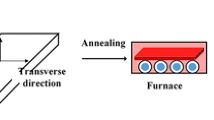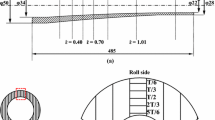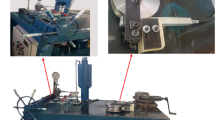Abstract
The tube flaring process has been traditionally used to expand one end of a tube without changing its cross-sectional area. This process can be achieved by driving a rigid conical punches or arc profile punches with various diameters inserting into the tube end either mechanically or hydraulically, to obtain desirable expansion ratios. In this study, taking the Zircaloy-4 tubes with different textures as the samples, a three-dimensional (3D) finite element model is established to simulate the process of flaring and the reliability of the model has been validated by experiments. Via an integration method using the subroutine Vumat in the Abaqus/Explicit platform, the effect of punch parameter (E) on the forming quality of flared tube has been revealed. Besides, the analyses for the flaring load, wall thickness variation, stress–strain path, and texture evolution are also carried out via the experimentation and simulation. It is observed that the tube flared by the punch with E = 2.0 has a lower wall-thinning ratio so that the higher formability is achieved. To prevent the local bulking during flaring, the value of E with the range of 0 to 2.5 is reasonable. Furthermore, the relationship between strain ratio and texture evolution is constructed.























Similar content being viewed by others
Data availability
No applicable.
References
Leu DK (2000) The curling characteristics of static inside-out inversion of metal tubes. Int J Mach Tool Manu 40(1):65–80. https://doi.org/10.1016/S0890-6955(99)00046-2
Wang QL, Zhan M, Li HW, Li YY, Rong J, Li GJ (2019) Research on forming mechanism and process of double flaring tubes with large diameter and thin wall. J Plast Eng 26(3):104–112
Barsoum I, Khan F, Molki A, Seibi A (2014) Modeling of ductile crack propagation in expanded thin-walled 6063–T5 aluminum tubes. Int J Mech Sci 80:160–168. https://doi.org/10.1016/j.ijmecsci.2014.01.012
Mirzai MA, Manabe KI, Mabuchi T (2008) Deformation characteristics of microtubes in flaring test. J Mater Process Technol 201(1–3):214–219. https://doi.org/10.1016/j.jmatprotec.2007.11.230
Wu WC, Huang Y, Malhotra R, Wang YJ, Cao J (2010) Experimental and numerical analysis of titanium microtube elliptical flaring. In: ASME International Manufacturing Science and Engineering Conference, Erie, USA
Yeh FH (2007) Study of flaring forming limit in the tube flaring process. J Strain Anal Eng 42(5):315–324. https://doi.org/10.1243/03093247JSA272
Shann SH, Swam LF (1994) Creep anisotropy of Zircaloy-2 cladding during irradiation. Nucl Eng Des 148(1):17–25. https://doi.org/10.1016/0029-5493(94)90238-0
Li ZX, Zhan M, Guo K, Huang T (2017) Texture development of Ti-3Al-2.5V titanium alloy tubes. Rare Metal Mat Eng 46(11):3169–3175
Zhang HL, Liu YL (2016) The inverse parameter identification of Hill’48 yield function for small-sized tube combining response surface methodology and three-point bending. J Mater Res 32(12):2343–2351. https://doi.org/10.1557/jmr.2017.82
Karajibani E, Fazli A, Hashemi R (2015) Numerical and experimental study of formability in deep drawing of two-layer metallic sheets. Int J Adv Manuf Technol 80(1–4):113–121. https://doi.org/10.1007/s00170-015-6978-5
Liu J, Jaiman RK, Gurugubelli PS (2014) A stable second-order scheme for fluid–structure interaction with strong added-mass effects. J Comput Phys 270:687–710. https://doi.org/10.1016/j.jcp.2014.04.020
Nikhare CP, Korkolis YP, Kinsey BL (2016) Formability enhancement in titanium tube -flaring by manipulating the deformation path. J Manuf Sci Eng Trans ASME 137(5):051006. https://doi.org/10.1115/1.4030512
Yeh CH, Yang CH (2011) Characterization of mechanical and geometrical properties of a tube with axial and circumferential guided waves. Ultrasonics 51(4):472–479. https://doi.org/10.1016/j.ultras.2010.11.013
Li H, Fu MW, Lu J, Yang H (2010) Ductile fracture: experiments and computations. Int J Plast 27(2):147–180. https://doi.org/10.1016/j.ijplas.2010.04.001
Li H, Zhang HQ, Yang H, Fu MW, Yang H (2017) Anisotropic and asymmetrical yielding and its evolution in plastic deformation: titanium tubular materials. Int J Plast 90:177–211. https://doi.org/10.1016/j.ijplas.2017.01.004
Acknowledgments
We would like to thank the Analytical & Testing Center of Northwestern Polytechnical University for TEM testing.
Funding
This work was supported by the National Natural Science Foundation of China (No.51771150), the National Key Research and Development Program of China (No. 2016YFB0701303), and the Natural Science Foundation of Shaanxi Province (2018JM5174).
Author information
Authors and Affiliations
Contributions
Wang Xufeng: conceptualization, methodology, investigation, formal analysis, data curation, writing-original draft, writing—review and editing; Huang Xiaoyu: conceptualization, supervision, writing—review and editing, funding acquisition; Xue Xiangyi: conceptualization, methodology, supervision; Zhang Haiqin: methodology, investigation; Zhou Jun: formal analysis; Liu Haiming: investigation, formal analysis; Tang Bin: funding acquisition; Kou Hongchao: conceptualization, methodology; Li Jinshan: conceptualization, methodology.
Corresponding authors
Ethics declarations
Consent to participate
No applicable.
Consent for publication
All authors agree to transfer the copyright of this article to the publisher.
Competing interests
The authors declare no competing interests.
Additional information
Publisher's Note
Springer Nature remains neutral with regard to jurisdictional claims in published maps and institutional affiliations.
Rights and permissions
Springer Nature or its licensor (e.g. a society or other partner) holds exclusive rights to this article under a publishing agreement with the author(s) or other rightsholder(s); author self-archiving of the accepted manuscript version of this article is solely governed by the terms of such publishing agreement and applicable law.
About this article
Cite this article
Wang, X., Huang, X., Xue, X. et al. Experimental and numerical study of the flaring process for Zircaloy tube end. Int J Adv Manuf Technol 126, 2219–2232 (2023). https://doi.org/10.1007/s00170-023-11174-x
Received:
Accepted:
Published:
Issue Date:
DOI: https://doi.org/10.1007/s00170-023-11174-x




